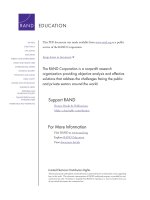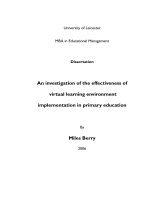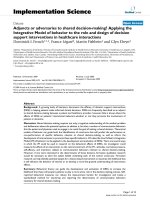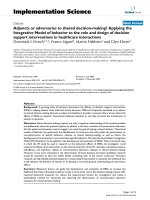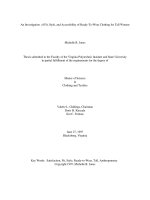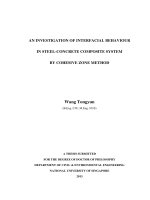Decision making in sports an investigation of 12 to 19 years old basketball players in singapore
Bạn đang xem bản rút gọn của tài liệu. Xem và tải ngay bản đầy đủ của tài liệu tại đây (3.06 MB, 187 trang )
DECISION MAKING IN SPORTS: AN INVESTIGATION OF 12- TO
19-YEAR-OLD BASKETBALL PLAYERS IN SINGAPORE
NG YUWEN STELLA
NATIONAL UNIVERSITY OF SINGAPORE
2014
DECISION MAKING IN SPORTS: AN INVESTIGATION OF 12- TO
19-YEAR-OLD BASKETBALL PLAYERS IN SINGAPORE
NG YUWEN STELLA
(B.Eng (Hons), National University of Singapore)
A THESIS SUBMITTED
FOR THE DEGREE OF DOCTOR OF PHILOSOPHY
DEPARTMENT OF INDUSTRIAL AND SYSTEMS ENGINEERING
NATIONAL UNIVERSITY OF SINGAPORE
2014
i
ACKNOWLEDGEMENTS
I would like to thank my supervisors, Associate Professor Tan Kay
Chuan and Professor John Brian Peacock, for their continuous support and
guidance throughout this research project. They have taught me a lot about the
research process and are constantly aware of my research progress. Through
their contacts, I was also able to spend a month at Loughborough University in
England to better understand and be involved in the different types of sports
science research projects. This experience was very useful in enhancing and
supporting my research.
I would also like to thank the Department of Industrial and Systems
Engineering, National University of Singapore, for offering me a full
scholarship to complete my graduate studies. The staff and fellow graduate
students of the department also played an important part in the completion of
my research project.
Lastly, I am grateful for the constant support and encouragement from
my family and friends. In particular, I would like to thank Ms Tang Ching Yun
for introducing me to the other basketball coaches so that I can gather enough
participants for my research, and Ms Angeline Koh and Ms Wong Hwee Bee
for their valuable input on the analysis of my research data. Without them, I
would not be able to successfully complete my research.
This thesis is dedicated to my aunt who passed away on 11 September
2013. Thank you for taking care of me for the past 28 years. I will always
remember how you loved, encouraged and supported me all these years. No
words can express how much I miss you.
ii
DECLARATION
I hereby declare that the thesis is my original work and it has been written by
me in its entirety. I have duly acknowledged all the sources of information
which have been used in the thesis.
This thesis has also not been submitted for any degree in any university
previously.
_________________________
Ng Yuwen Stella
1 August 2014
iii
TABLE OF CONTENTS
ACKNOWLEDGEMENTS i
DECLARATION ii
TABLE OF CONTENTS iii
SUMMARY v
LIST OF TABLES vii
LIST OF FIGURES ix
LIST OF ACRONYMS AND BASKETBALL TERMS x
1 INTRODUCTION 1
1.1 Research Motivation 1
1.2 Scope and Flow of Research Work 3
1.2.1 Scope of research work 3
1.2.2 Flow of research work 4
1.3 Brief Overview of Published and Submitted Work 4
1.4 Conclusion 6
2 LITERATURE REVIEW 7
2.1 Decision Making 7
2.1.1 Different approaches of research in decision making 7
2.1.2 Decision making and ergonomics 8
2.1.3 Decision making under stress 12
2.2 Sports 17
2.2.1 Research in sports 18
2.2.2 Decision making in sports 19
2.2.3 Challenges in the research of decision making in
sports 27
2.3 Conclusion 30
3 RESEARCH GAPS, OBJECTIVES AND QUESTIONS 32
3.1 Research gaps 32
3.1.1 Gap 1: Lack of understanding in how the different
cognitive components contribute to decision making 32
3.1.2 Gap 2: No formalized tools or methods to evaluate
cognitive abilities in sports 37
3.1.3 Gap 3: Limited application of the concept of NDM in
sports 39
3.2 Research objectives and questions 43
3.2.1 Research objectives 43
3.2.2 Research questions 44
iv
4 STUDY 1: PAPER-BASED RATING SHEET FOR COACHES 45
4.1 Preparation and development 45
4.1.1 Kano model 45
4.1.2 Results and analysis of Kano questionnaire 49
4.2 Data collection 53
4.2.1 Research participants 53
4.2.2 Research procedure 53
4.3 Results and analysis 54
4.4 Discussion 61
5 STUDY 2: COMPUTERIZED TEST FOR PLAYERS 67
5.1 Preparation and development 68
5.1.1 Cognitive and emotional components of decision
making in sports 68
5.1.2 Testing and improving the cognitive test app 74
5.1.3 Final version of cognitive test app 75
5.2 Data collection 77
5.2.1 Research participants 77
5.2.2 Research procedure 78
5.3 Results and analysis 79
5.4 Discussion 84
6 STUDY 3: BASKETBALL PERFORMANCE STATISTICS 97
6.1 Data collection 97
6.2 Results and analysis 101
6.3 Discussion 109
7 GENERAL DISCUSSION 116
7.1 How can we measure decision making? 116
7.2 How does decision making affect sports performance? 121
8 CONCLUSION AND FUTURE WORK 130
8.1 Introduction 130
8.2 Contributions 130
8.3 Limitations and challenges of this study 134
8.4 Recommendation for future research 136
References 139
Appendix A – Kano questionnaire used to categorize decision making
attributes 161
Appendix B – Rating sheet for coaches provided to coaches 167
Appendix C – Screenshots of decision making app test (instructions for
each section) 168
v
SUMMARY
Decision making has been a popular research topic across many
disciplines. Decision research originated from the mathematical perspective,
commonly known as the classical theory of decision making. Yet, it was later
realised that the classical theory does not explain human decision making
behaviour. This led to the rise of the psychological perspective of decision
research, where researchers focused on the contexts and factors that affect
human decision making processes.
The main aim of this thesis was to investigate human decision making
behaviour in sports scenarios. A rating sheet and a computerized cognitive test
were developed for this research study to measure the cognitive fitness of
teenage basketball players in Singapore. The five main cognitive components
required for decision making in basketball were competitive anxiety, short-
term spatial memory, situation awareness, domain knowledge, and learning
ability. The participants’ basketball performance statistics from their first and
last matches of their competitive leagues were also collected and coaches were
engaged to provide expert judgement on the participants’ decision making
performance during basketball games. Results from the rating sheet and
computerized cognitive test, as well as the basketball performance statistics
were compared with that of the coaches’ judgements. In addition, measures of
the participants’ physical fitness were also obtained. The participants’ results
during their annual National Physical Fitness Award (NAPFA) test were
collected and used as measures of their physical fitness in this research study.
vi
Thus, the effects of physical fitness, cognitive abilities, and experience on
actual basketball performance were also evaluated in this thesis.
Our findings showed that the rating sheet for coaches was best able to
predict the coaches’ selection of the better and poorer decision makers in their
teams. Although the computerized cognitive test provided objective
assessments of the participants’ cognitive abilities, the tools used in the test
lacked the sensitivity to distinguish between the junior experts and novices in
this experiment. Analysis of the participants’ performance statistics showed
that the better decision makers had significantly more playing time, attempted
points per minute of playing time, and points scored per minute of playing
time for both matches.
In recent years, the Direct School Admission (DSA) programme led
many schools to conduct trials for the selection of potential athletes for various
sports. The task of talent selection has never been easy, especially when the
coaches only have a few hours to observe their prospective players. Coaches
explained that it would be most useful to be able to identify players with
superior cognitive abilities as it is easier to train physical fitness and sports
skills. As such, three methods of diagnosing decision making abilities of
basketball players were compared in this thesis. It was hoped that this work
would be useful for practitioners in identifying youths with good decision
making capability and provide insights on diagnosing human decision making
performance.
vii
LIST OF TABLES
Table 3.1 Existing experimental tools and methods used to study
decision making and its related cognitive components 34
Table 4.1 Scale used in Kano questionnaire 48
Table 4.2 Number of respondents for each target group 50
Table 4.3 Matrix used to map attributes and categorize them into
the Kano categories 51
Table 4.4 Decision making attributes selected for use in rating sheet 51
Table 4.5 Comparison of coaches’ judgments on the top half and
bottom half groups 56
Table 4.6 Discriminant function and structure matrix of coaches’
ratings for top half and bottom half groups 57
Table 4.7 Classification results of coaches’ ratings for top half and
bottom half groups 57
Table 4.8 Order of importance of cognitive components for different
target groups 59
Table 4.9 Comparison of spectators’ judgments on the top half and
bottom half groups 59
Table 4.10 Discriminant function and structure matrix of
spectators’ ratings for top half and bottom half groups 60
Table 4.11 Classification results of spectators’ ratings for top and
bottom half groups 61
viii
Table 5.1 List of situation awareness queries for each basketball
scenario 71
Table 5.2 Composition of players in each division 78
Table 5.3 Summary of decision making test results 80
Table 5.4 Comparison of discriminant analyses for computerized
decision making test 82
Table 5.5 ANOVA comparison of change in decision making test
results over one competitive season 83
Table 6.1 List of performance statistics and cognitive constructs 99
Table 6.2 Dates and competition levels of first and last matches 100
Table 6.3 ANOVA comparison of basketball performance statistics 102
Table 6.4 Discriminant function and structure matrix of basketball
performance statistics for top half and bottom half groups 104
Table 6.5 Classification results of performance statistics of first and
last matches 105
Table 6.6 Statistically significant regression coefficients of
basketball performance statistics 108
Table 7.1 Comparison of the three methods of diagnosing decision
making ability in basketball players 120
ix
LIST OF FIGURES
Figure 2.1 A model of human information processing (Wickens
1992, p17) 9
Figure 2.2 Graphical description of the relationship between arousal
and performance developed by Hebb in 1955 (Teigen 1994, p533) 14
Figure 2.3 An illustration of the three levels of human performance
(Rasmussen 1993, p258) 16
Figure 2.4 Number of sports related articles indexed by Scopus per
year up to 28 December 2013 18
Figure 2.5 A model of the decision making process of athletes
developed by Tenenbaum (2003, p195) 20
Figure 3.1 A fuzzy model of the cognitive process (Peacock & Chai,
2012) 40
Figure 4.1 Kano model adapted from Berger et al. (1993) 48
Figure 5.1 Adapted model used for the development of cognitive test 68
Figure 5.2 Flowchart of main goals and sub-goals in basketball 70
x
LIST OF ACRONYMS AND BASKETBALL TERMS
ANOVA: Analysis of Variance
CSAI-2: Competitive State Anxiety Inventory-2
DESSY: Dynamic Environment Simulation System
DSA: Direct School Admission
GPAI: Game Performance Assessment Instrument
IRB: Institutional Review Board
IZOF: Individual Zone of Optimal Functioning
MLR: Multiple Linear Regression
NAPFA: National Physical Fitness Awards
NDM: Naturalistic Decision Making
SAGAT: Situation Awareness Global Assessment Technique
SPSS: Statistical Package for the Social Sciences
Assist: A pass that leads directly to a basket.
Box-out: Using one’s body to stay between an opponent and the basket
and get into a better position for rebound.
Double-team: The defensive tactic of two players guarding one.
Fast-break: A play in which a team gains possession and then pushes the
ball downcourt quickly, hoping to get a good shot off before the
other team has a chance to get back and set up on defense.
Key: The painted area between the end line and the free-throw line
near each basket, outside which players line up for free throws.
In the early years, it was key-shaped and has since widened
twice to its present rectangular shape.
Lay-up: A shot with one hand from a point close to the basket, in which
a player shoots the ball toward the basket, often off the
backboard.
Personal foul: A violation that is usually due to an illegal contact between two
players.
Rebound: Gather in and gain control of a missed shot; a missed shot that
is retrieved.
Shot-clock: The 24-second clock used to time possessions. A team must
attempt a shot that hits the rim within 24 seconds or else it loses
possession of the ball.
Steal: To take the ball away from the opposing team, either off the
dribble or by picking off a pass.
Turnover: Loss of ball, either through an errant pass or dribble or an
offensive foul.
(Dictionary.com; NBA.com, 2001)
1
1 INTRODUCTION
1.1 Research Motivation
In the Oxford Dictionaries (2011), decision is defined as “a conclusion
or resolution reached after consideration”, with the focus being on the “action
or process” by which the conclusion is reached. Despite this definition, most
people tend to judge a decision based on its outcome. However, to study
decisions and judge if a decision is indeed ‘good’ or ‘bad’, the nature of the
decision making task has to be studied in detail. This should be judged based
on the information available and the uncertainties at that point in time, and not
on the consequence of the decision (Wickens, 1992a). Therefore, a ‘good’
decision with the highest probability of success can still lead to a ‘bad’
consequence, and likewise, a ‘bad’ decision with the lowest probability of
success can still lead to a ‘good’ consequence.
There are two main theoretical perspectives in decision making
research and both hold differing assumptions (Mascarenhas & Smith, 2011).
Decision research first started from the mathematical perspective where
theorists explain decision biases with statistical analysis. As such, researchers
in this area believe that statistical modelling can help decision makers to select
the optimal choices. This perspective is commonly known as the classical
theory of decision making (G. Klein, Orasanu, Calderwood, & Zsambok,
1993). However, it was later realized that the classical theory of decision
making does not explain human decision making behaviour. Even in situations
where decision makers were taught the classical theory of decision making, it
was observed that they rarely apply the knowledge (Mascarenhas & Smith,
2
2011). Therefore, researchers began to investigate and understand human
decision making from a psychological perspective, taking into account the
context where the decision is made and the factors that affect decision making
processes.
The presence of stress has a large effect on decision making abilities.
There are many different types of stressors and they often make decision
making a challenge. Such stressors include lack of knowledge, limited time, or
even risk to life and property (Field, 1987; G. Klein, Calderwood, & Clinton-
Cirocco, 2010; Oppe, 1988). One significant stressor that is often found in
decision making situations is time pressure. Decision making under time
pressure often leads to other physical (e.g. degraded performance due to lack
of sleep), physiological (e.g. increased heart rate or blood pressure) or
psychological stressors (e.g. frustration and fear). (G. Klein et al., 1993)
The ability to make good decisions is important to everyone as every
individual faces various decision making situations every day. Although most
research in decision making focuses on applications with a greater impact, the
“scientific study of decision making should have (and could have) applications
to all areas of our society” (G. Klein, 1999). One of the possible applications
could be in the area of decision making in sports games. In the world of sports,
a wide range of cognitive processes associated with human judgment and
decision making is involved and people start to make decisions in sports at a
much younger age than in situations where there are more impactful outcomes.
Thus, the sports arena is a potential laboratory that is appropriate for research
in decision making. (M Bar-Eli & Raab, 2006)
3
Decision making under time stress is also evident in sports where
players have very limited time to obtain, interpret, analyze information and
decide on their course of action as the situation continuous develops. In most
sports games such as basketball, tennis and football, players are faced with a
dynamic environment that changes due to external factors or as a result of
other players’ actions. The results of their decisions can be seen almost
immediately. Knowing the results of their action choices quickly is important
in the study of decision making as feedback and learning plays a significant
role in the human information process model (Bridger, 2009).
1.2 Scope and Flow of Research Work
In this section, the scope of the current work done for this research area
is explained. Thereafter, a brief overview describing the organization of this
research thesis is presented.
1.2.1 Scope of research work
The research begins with a literature review on human decision making
behaviour and its applications in various areas. The literature review includes
topics such as:
o Definition of decision making
o Types of research in decision making
o Decision making theories and methodologies
o Studies of the effects of stress in decision making process
o Industries where decision making have been studied
4
Based on the literature review and findings, a framework to study decision
making in sports was proposed. This research framework was then used to
investigate the decision making performance of 12 to 19 years old basketball
players in Singapore. This study constitutes a main part of this research work.
Lastly, the research contribution, limitations, and recommendations for
future work are summarized.
1.2.2 Flow of research work
This thesis consists of nine main chapters. Chapter 1 presents the
introduction section which discusses the research motivation for decision
making under time stress and the scope of this research work. Thereafter,
Chapter 2 describes the literature review on human decision making theories
and research applications. In Chapter 3, the research gaps, objectives and
questions are explored, while Chapter 4 covers the preliminary case studies
and their findings. Chapters 5 and 6 describe the development of the research
instruments and the data collection process respectively. Next, Chapter 7
presents the results and analysis of the data collected. Finally, the last two
chapters of this thesis cover the discussion (Chapter 8), and conclusion and
recommendations (Chapter 9).
1.3 Brief Overview of Published and Submitted Work
Papers that have been published or submitted are summarized below.
• Paper 1: The preliminary studies for this research were published in
the Proceedings of the 3
rd
International Conference on Education and
5
Sports Education, April 1-2, 2012, Macau, China. This paper
corresponds to Chapter 4 of this thesis.
• Paper 2: A further analysis of the preliminary studies and its findings
was published in the Proceedings of the 2
nd
International Conference
of The Southeast Asian Network of Ergonomics Societies (SEANES),
July 9-12, 2012, Langkawi, Malaysia. This paper corresponds to
Chapter 4 of this thesis.
• Paper 3: An analysis of the effects of ageing on human physical
performance using the World Masters Athletics records. This paper
was published in the Proceedings of the 4
th
International Conference
on Applied Human Factors and Ergonomics (AHFE), July 21-25,
2012, San Francisco, United States of America.
• Paper 4: Presents an application of the proposed framework to
investigate the decision making performance in teenage basketball
players. This paper was published in the Proceedings of the 9
th
International Conference on Cognitive Sciences, August 27-30, 2013,
Kuching, Malaysia and in Procedia – Social and Behavioural Sciences,
2013, Vol. 97C, pp. 715-722. It corresponds to Chapters 4, 5, 6, 7, and
8 of this thesis.
• Paper 5: Describes a more comprehensive application of the complete
framework with a partial analysis of the results, comparing the
basketball players’ cognitive and physical fitness with their basketball
performance. This paper was published in the Proceedings of the
World Academy of Science, Engineering and Technology (WASET)
6
2013 International Conference on Sport Science, November 28-29,
2013, Malaga, Spain, which corresponds to Chapters 4, 5, 6, 7, and 8
of this thesis.
1.4 Conclusion
Decision making is an important cognitive function as everyone faces
various decision making situations every day. Early decision research focused
on the mathematical aspect, resulting in the development of many statistical
models and tools to help guide decision makers towards the optimal choices.
However, it was observed that most people do not make use of these models
and tools when making decisions. As such, researchers began to turn towards
the study of human decision making behaviour, where the situational context
is often a significant factor that affects decision making processes.
In particular, stress has a significant impact on human decision
making. There are various types of stressors in a decision making situation
such as time pressure. Sports provide a suitable ground for the study of human
decision making behaviour as athletes face a dynamic environment that
constantly evolves. Besides having to deal with various stressors, an athlete
also faces many other distractions during the game. In considering situational
factors, the concept of naturalistic decision making was proposed. This
concept will be explained in Chapter 2.
7
2 LITERATURE REVIEW
This chapter starts with an introduction of decision making as the main
theory of focus in this research proposal. It includes the definition of decision
making, the different types of theories and research in decision making, the
study of decision making in Ergonomics, decision making under stress, as well
as the challenges in decision making research.
The next part discusses the types of research in sports science and a
description of some of the cognitive studies that have been conducted in the
area of sports. Thereafter, a summary of the literature review is given.
2.1 Decision Making
Decision making is most commonly defined as “the selection of one
option from a set of two or more options” (G. Klein et al., 2010). As
mentioned in Chapter 1, the decision is analyzed separately from its
consequence in the study of decision making. With this, we shall first look at
the different types of research being done in the study of decision making.
2.1.1 Different approaches of research in decision making
The study of decision making has been researched in many distinct yet
interrelated disciplines (M Bar-Eli & Raab, 2006). A search of the keywords
“decision making” in Google Scholar has revealed about 1.24 million articles
in areas such as psychology, operational research, social science, management
science, computer science, neurology, organizational behaviour and human
performance.
8
G. Klein (1999) discussed the two themes in decision research that was
developed by Cohen and Doherty – a formal, mathematical paradigm and a
rationalist paradigm. The formal, mathematical paradigm is the classical
theory of decision making that considers the probability and value of outcome,
while the rationalist paradigm attempts to describe human behaviour in
judgment and decision making. The mathematical theme has led to the
development of methods that help in breaking down complex decisions and
determine the optimal choice, while the rationalist theme has valuable
contributions in the areas of training and support to aid the process of decision
making. Both themes are complementary and important in the research of
decision making. This is especially evident in situations whereby optimal
choices are required in human-machine systems (Bridger, 2009).
2.1.2 Decision making and ergonomics
Focusing mainly on human judgment and information processing, the
ergonomics perspective of decision making can be classified under the
rationalist paradigm as discussed by G. Klein (1999). In the field of
ergonomics, decision making is seen as “a complex process…(that) involves
seeking information relevant to the decision at hand, estimating probabilities
of various outcomes, and attaching values to the anticipated outcomes”. Thus,
decision making “is at the heart of information processing” (Sanders &
McCormick, 1992).
Wickens (1992a) explained why people may not make the best
decision with the information that they have on hand by studying the features
of the decision making task. When a person is tasked to make a decision, he
9
starts by obtaining some cues from the environment and forms his own
perception of this information. Thereafter, he develops his diagnosis of the
situation using both his long-term memory and working memory. With this
initial diagnosis, the decision maker may then decide to hold back and search
for more information or proceed with his choice of action. Figure 2.1 below
illustrates how decision making interacts with the other functions of the
human information process. From this figure, it can be noted that limitations in
any aspect of the human information processing capabilities, such as one’s
memory or attention span, can affect decision making. Wickens (1992a) also
mentioned that limitations in human biases affect one’s perceptions and
inferences of statistical estimation, which leads to a less than perfect choice of
action.
Figure 2.1 A model of human information processing (Wickens 1992, p17)
The information processing model for decision making can be
summarized into four broad stages (Bridger, 2009). The first stage is known as
the information acquisition stage where the decision maker searches for
10
information and specifies the alternatives. Next, he goes on to evaluate the
alternative courses of action. This stage has been greatly researched and there
are many models and decision strategies developed for this stage of the
decision making process. Once the course of action is decided, he proceeds to
the execution stage. Lastly, he reaches the stage of obtaining feedback after
the action has been executed. This stage is important as it allows the decision
maker to learn and gain expertise in decision making skills. As one gains more
experience in decision making, this increase in expertise can affect future
decision making processes. There are various benefits and limitations of
expert decision making. Wickens (1992a) listed some of the main benefits and
biases as shown below.
Benefits
• Cue sampling: Due to their huge amount of experience, experts are
able to identify and perceive new information more efficiently. Thus, reducing
the amount of time needed to understand the situation and decide on their
choice of action.
• Hypothesis and action generation: With a huge database of possible
hypotheses and actions already stored in their long term memory, expert
decision makers are able to recognize the patterns and diagnose the problems
with less time and effort.
• Risk and probability calibration: The increased domain knowledge
allows experts to have a better grasp of the actual probabilities of the states
and outcomes. As such, they are able to calibrate and make the necessary
adjustments to their diagnosis and choices by considering the current risks.
11
Biases
• Misleading feedback: As ‘wrong’ decision strategies may still lead to
good outcomes, and vice versa, experts may be misled by previous experience.
Therefore, it is more difficult for an expert to ‘unlearn’ an inappropriate
strategy that was correct by chance.
• Limited attention to delayed feedback: Fischhoff observed that experts
tended to be overconfident in their forecasting and attributed it to a lack of
attention to feedback. He labelled the phenomenon as cognitive conceit.
• Selective perception of feedback: In Einhorn and Hogarth’s
experiment, it was observed that decision makers tend to focus on the number
of successes, rather than the probability. Due to a host of factors, this leads to
a bias of attention against failures that causes experts to be overconfident of
their decision strategies.
• Selective influence on outcome: Following on the selective perception
of feedback, Einhorn and Hogarth further noted that most decision makers
have a vested interest in the success of their decision rules.
In summary, many ergonomics textbooks focus on heuristics and
biases in the study of human decision making (Bridger, 2009; Sanders &
McCormick, 1992; Wickens, 1992a). By understanding and considering
human capabilities and limitations, ergonomists contribute to the study of
decision making and suggest methods to assist the decision making process
and improve the quality of decisions made. These methods can help to present
information in a better way or even pre-processing information to facilitate the
decision making process.
